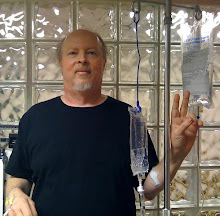Chronic lymphocytic leukemia is not the province of people alone. If you've been around Google a few times you've run into references of CLL in dogs and cats. Indeed, they're pretty much subject to the whole range of leukemias and lymphomas that we humans are. When it comes to CLL, our pets get some of the same treatments that we do. CLL kitties can live a year or two if given chlorambucil. French researchers found that dogs responded to a combination of prednisolone and melphalan (the latter being an older drug that is rarely used in human CLL today).
The animal world has lost its first CLL celebrity, a sea otter named Nyac. She was a 20-year-old survivor of the Exxon Valdez oil spill and a popular resident of the Vancouver Aquarium. Whether or not the oil spill had anything to do with her CLL is unknown, but it didn't seem to interfere with her longevity. Sea otters usually live 10 or 15 years and some have reached 20 in captivity, so she died at a ripe old age.
A statement by the Vancouver Aquarium on Tuesday read in part:
"Nyac was at the upper limit of a female sea otter life span. Over the last 2-3 years Nyac has been showing signs of her advanced age most obviously a gradual slowing down in her general behaviours. In July, Nyac suddenly showed limited energy and mobility. The Aquarium’s veterinary team immediately began their work in an attempt to determine a reason for the sudden deterioration of Nyac’s health. An MRI revealed a serious inner ear infection however blood test results showed a more serious underlying disorder.
"With treatment, Nyac’s behaviour improved and since that time she had been under close observation by the marine mammal and veterinary care teams. Last Friday her condition worsened and she was diagnosed with chronic lymphocytic leukemia.
"Nyac was placed under 24-hour care with key staff in attendance. Her condition continued to worsen until Nyac passed away early this morning.
“Nyac was a very special animal and had been placed under palliative care. Our entire veterinary and marine mammal care team is, of course, devastated this morning. Lymphocytic leukemia has not been previously reported in sea otters and because there is some association with contact with petroleum in other species, she is an important animal. From a medical perspective, Nyac is also very important because of her long life. Even as we’ll miss her we know she’ll continue to provide vital information on the long-term effects of oil exposure.” said Dr. Martin Haulena, Staff Veterinarian, Vancouver Aquarium."
Below is the YouTube video that made her famous. Get out your hankies.
My personal decision to restart my CLL (chronic lymphocytic leukemia)
treatment
-
I have good reasons to believe it is time to re-treat my CLL.
Before deciding on the best therapy choice to treat my CLL/SLL (chronic
lymphocytic leukemia/...
8 months ago













